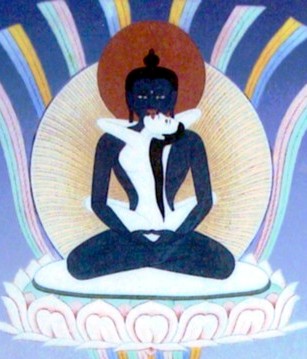Buddha Samantabhadra: Difference between revisions
Jump to navigation
Jump to search
mNo edit summary |
|||
| Line 17: | Line 17: | ||
==Further Reading== | ==Further Reading== | ||
*The [[Dzogchen Ponlop Rinpoche]], ''Penetrating Wisdom: The Aspiration of Samantabhadra'', (Ithaca: Snow Lion Publications, 2006), pages 33-37. | *The [[Dzogchen Ponlop Rinpoche]], ''Penetrating Wisdom: The Aspiration of Samantabhadra'', (Ithaca: Snow Lion Publications, 2006), pages 33-37. | ||
*Karl Brunnhölzl, ''A Lullaby to Awaken the Heart: The Aspiration Prayer of Samantabhadra and Its Tibetan Commentaries'', (Sommerville: Wisdom Publications, 2018), pages 12-30. | |||
==Notes== | ==Notes== | ||
Revision as of 14:49, 8 April 2022

Samantabhadra (Skt.; Tib. ཀུན་ཏུ་བཟང་པོ་, Kuntu Zangpo; Wyl. kun tu bzang po) — In the Dzogchen teachings, our true nature, that state of the Ground, is given the name the 'Primordial Buddha'. Sogyal Rinpoche writes, "[Kuntuzangpo] represents the absolute, naked, sky-like primordial purity of the nature of our mind".[1]
He is depicted as a buddha, sky-blue in colour, sitting in the vast expanse of space, and encircled by an aura of rainbow light. He is completely naked, meaning unstained by any trace of concept. His name, Kuntuzangpo in Tibetan, Samantabhadra in Sanskrit, means ‘always good', ‘always well’ or ‘unchanging goodness.’ What this signifies is that unchanging goodness, or fundamental goodness, is our ultimate nature.
The Five Aspects of Kuntuzangpo
- Tönpa Kuntuzangpo
- Gyen Kuntuzangpo
- Lam Kuntuzangpo
- Rigpa Kuntuzangpo
- Tokpa Kuntuzangpo
Teachings About Kuntuzangpo
- Dzongsar Khyentse Rinpoche, Rigpa London, 8 February 1992
- Sogyal Rinpoche, Berlin Centre, 4 June 2011
Further Reading
- The Dzogchen Ponlop Rinpoche, Penetrating Wisdom: The Aspiration of Samantabhadra, (Ithaca: Snow Lion Publications, 2006), pages 33-37.
- Karl Brunnhölzl, A Lullaby to Awaken the Heart: The Aspiration Prayer of Samantabhadra and Its Tibetan Commentaries, (Sommerville: Wisdom Publications, 2018), pages 12-30.
Notes
- ↑ The Tibetan Book of Living and Dying, page 106.